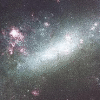 |
||
| First page | ||
 |
||
| Milky way | ||
 |
||
| Spiral galaxies | ||
 |
||
| Elliptical galaxies | ||
 |
||
| Irregular galaxies | ||
 |
Quasars | |
 |
||
| Find out more | ||
 |
||
 |
||
 As many as 25 percent of all galaxies cannot be categorised into either spiral or elliptical and are therefore called irregular galaxies. They have 20 to 50 percent of their mass in interstellar matter, gas and dust, and this is why these galaxies have active star formation regions with many bright, young star clusters and clouds of ionized gas.
As many as 25 percent of all galaxies cannot be categorised into either spiral or elliptical and are therefore called irregular galaxies. They have 20 to 50 percent of their mass in interstellar matter, gas and dust, and this is why these galaxies have active star formation regions with many bright, young star clusters and clouds of ionized gas.
Irregulars don't show any trace of circular symmetry but have a chaotic and irregular appereance. The stars are distributed at random throughout the galaxy and this is why most irregulars are small and faint. It's believed that dwarf irregulars could be the most common type of galaxy in the universe, but since dwarf galaxies far away are too faint to spot we can't know for sure.
 The most well known irregular galaxies are the large and small Magellanic clouds which can be seen as fuzzy clouds from the Southern Hemisphere. They orbit the Milky way and are our closest extragalactic neighbours, only about one-tenth as distant as our closest spiral galaxy, Andromeda. The images on this page are of the large (above) and small (left) Magellanic clouds.
The most well known irregular galaxies are the large and small Magellanic clouds which can be seen as fuzzy clouds from the Southern Hemisphere. They orbit the Milky way and are our closest extragalactic neighbours, only about one-tenth as distant as our closest spiral galaxy, Andromeda. The images on this page are of the large (above) and small (left) Magellanic clouds.
26th July 2000
Sarah Amandusson
www_astro@mssl.ucl.ac.uk